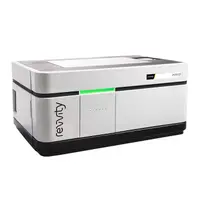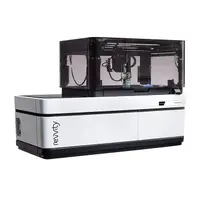Confocal Imaging

Confocal imaging improves the signal to noise ratio and the z-resolution in microscopy by placing a pinhole in the confocal plane, which allows light from focal plane to pass while rejecting light from out of focus planes. Spinning disk confocal microscopy offers several advantages over conventional optical microscopy, including widefield and laser scanning confocal microscopy. This confocal imaging technique allows acquisition of images at very high frame rates with minimum illumination of samples. These qualities make spinning disk confocal microscopy particularly well suited to high speed 2D and 3D imaging of fixed cells and living systems with minimal photo-bleaching.
A spinning disk confocal scanner uses rotating disks with thousands of pinholes typically arranged in an Archimedean spiral. As light is projected on to the disk the majority of the incident light is reflected but the holes trace concentric arcs of excitation light across the sample. Fluorescent light from the focal plane of the specimen returns along the same path through the objective lens and the pinhole, and is reflected by the dichroic mirror through a relay lens to the detector. As the whole field of view is scanned in this way during a single camera exposure a high quality confocal image is formed very quickly which, combined with fast large format sCMOS cameras, allows the capture of high quality confocal microscopy images at high speed.
Single spinning disk systems work with any type of light source but may suffer from pinhole crosstalk when imaging thick samples as you need to compromise between an optimal pinhole to pinhole distance and light transmission of the disk. This can be overcome by a dual disk design in which a carefully-aligned microlens disk focuses the excitation light onto the pinholes significantly increasing transmission even when pinholes are spaced further apart. For this approach to work, a point source, i.e. laser, is required for excitation.
Confocal microscopy using Revvity's Synchrony Optics™ enables simultaneous confocal acquisition while addressing both: pinhole crosstalk and excitation crosstalk. It features a microlens enhanced dual disc design with a pinhole distance optimized for thick samples such as 3D microtissues and dual field excitation which separates excitation of neighbouring spectral channels in space and time. This results in fast multichannel 3D acquisition at high image quality.
Following acquisition, the confocal images need to be analyzed so that insights and conclusions can be drawn. Confocal image analysis is a process of making quantitative structural and functional measurements. With the trend to quantitate images combined with the increasing use of complex 3D cell models, there is a growing need for 3D analysis of confocal images.
With Harmony® high-content analysis software from Revvity, you can analyze confocal images to measure morphology, volume, and texture in 3D. For example, you can count nuclei within spheroids and calculate XYZ positional properties, and analyze your z-stack as maximum intensity projection with 3D information preserved. With this numerical data, researchers can identify patterns and gain new insights from cellular samples.

Synchrony Optics separate the lightpaths for adjacent excitation lines to minimize crosstalk during simultaneous imaging and maximize speed and sensitivity.
Operetta CLS high-content analysis system features a single spinning pinhole disk to achieve confocality. In such a setup less than 5% of the incident light passes the disc and is available for excitation. Therefore Operetta CLS uses a flexible high power LED source with direct injection to maximize excitation energy. Water immersion objectives further improve performance, providing you with a flexible high performance confocal imager.
Opera Phenix Plus high-content screening (HCS) system employs Synchrony Optics and water immersion objectives to enhance the imaging performance that is essential when screening a large number of samples on a daily basis. The Opera Phenix™ Plus, our premier HCS platform benefits from spinning disk technology for the ultimate in high speed image capture and performance.
For research use only. Not for use in diagnostic procedures.
Featured products
of 2
Questions?
We’re here to help.
Contact us Please note that product labeling (such as kit insert, product label, and kit box) may be different compared to the company branding. Please contact your local representative for further details.






























